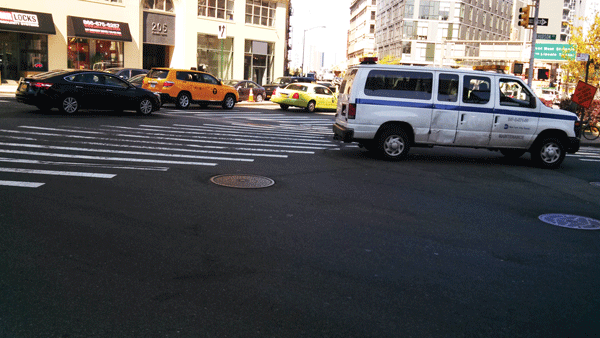
A Metropolitan Transportation Authority vehicle crosses Canal against the light when would-be pedestrians still had time to pass.
BY JOSH ROGERS | It almost seems as if there’s been a Canal St. traffic study for every car on the street.
The roadway has long been a source of government-funded efforts — some with catchy acronyms like CATS, the Canal Area Transportation Study — so it was not surprising Canal is one of the 13 streets the city is trying to make safer with an “arterial slow zone.”
Of the targeted areas, Canal is the deadliest per mile, according to the statistics the city Dept. of Transportation released with last week’s announcement about the zones.
While other city streets like Queens Boulevard and Atlantic Ave. in the Bronx have seen many more deaths since 2008 (23 and 25) than Canal’s six, they’re about a death per mile lower than the 4 to 1 ratio on Canal’s shorter, one-and-a-half mile stretch.
And although there were six deaths too many on the street, that was actually a vast improvement over some years ago when there were 14 deaths over the six years ending in 2001, as Downtown Express reported previously.
The slow zone will have a modest drop in speed limit from 30 to 25 miles per hour, but even more importantly, there will be speed limit signs, more enforcement and focus.
The last one is probably the most important, because the reality is speeding is not the big problem on Canal.
I’m sure many frustrated drivers turning off the West Side Highway waiting to get into the Holland Tunnel, or stuck as they wait to cross the Manhattan Bridge, would be willing to pay the price of a speeding ticket if that would get them moving faster.
I’ve spent most of the last 13 years working on or near Canal, so I’ve crossed and walked the street thousands of times. I occasionally bike there and have driven there a few times. I bike Downtown all of the time, but Canal, despite its convenient location, is a street I try to avoid because there’s little room between the trucks and cars.
The street is a clear physical barrier that also literally divides Community Boards 1 and 2. That is one of the reasons that Lower Manhattan school advocates don’t see a proposed school just near Canal as a solution to school overcrowding problems because it would mean students as young as 4 would be crossing the thoroughfare.
Vehicles so dominate the area they overwhelm pedestrians trying to cross the five to seven lanes of two-way traffic, or the long intersection at Hudson St. which sandwiches the tunnel entrance. I was at Hudson for only a few minutes this week before I saw an M.T.A. van cross Canal against the light, but fortunately there were no pedestrians nearby.
There have been minor tweaks to the street over the years, which probably have helped reduce the death rate, but in all the years of walking the area at many different hours, I can’t recall an instance of witnessing a near disaster, let alone an actual accident.
What I do see almost daily is many people who are obviously in fear because they walk so cautiously.
What’s needed is larger, more prominent crosswalks to send the unmistakable Ratso Rizzo message to drivers: “I’m walkin’ here.” (Dustin Hoffman’s most famous line from “Midnight Cowboy” was adlibbed when an impatient New York cabbie almost ran him over during filming.)
Northern Boulevard, the site of D.O.T.’s slow zone announcement, will also be getting safer crosswalks at an intersection near a school. It is almost undoubtedly needed there, although it is notable that the boulevard’s zone is almost three times the length of Canal but has had one fewer death since 2008, five.
As of now, there are no plans for additional safety measures in Lower Manhattan.
The focus and stepped up enforcement on Canal will undoubtedly help. It’s all part of Mayor de Blasio’s worthy Vision Zero goal of eliminating all traffic deaths.
In a practical sense, adding signs will make the speed limit drop infinite since many city drivers are unaware of a specific limit because they rarely see a sign.
The street is likely to get safer, but if the city wants to make it safe, officials might want to dust off a study or two and find a few more ideas.

















